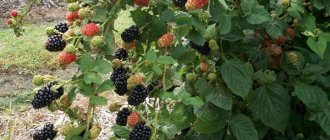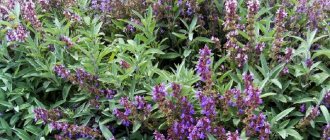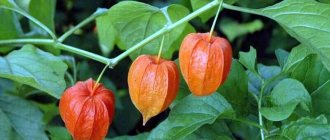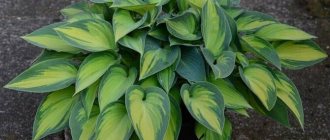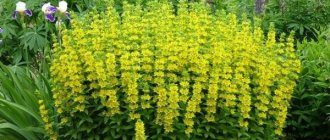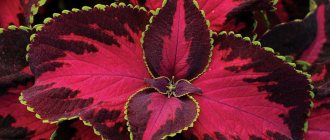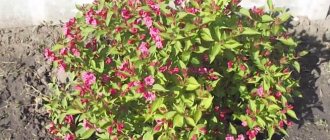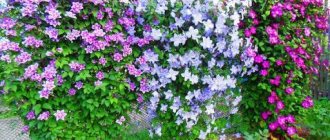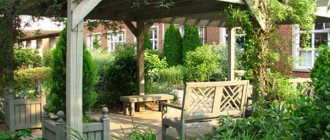General description of thuja
Thuja has excellent decorative properties. Looking at a photo of the western thuja, you can get a certain idea of what it will look like in the landscape.
This tree is very durable. Many gardeners are engaged in its cultivation; it is quite popular among landscape designers. The wood is used for carving and making furniture.
The crown of the tree has a pyramidal or oval shape, the roots are compact in size. The tree is characterized by slow growth, reaching a height of 12-20 meters.
A young plant has smooth bark, its color is red-brown; with age, the bark acquires a gray-brown tint. In an old tree it peels off and narrow strips separate from the trunk.
The needles of the thuja are scaly green, 0.2-0.4 cm in size, and fit tightly to the branches. In winter, it acquires a brownish color. The lifespan of needles is 2-3 years, after this period they fall off along with small branches.
The fruits are small scaly cones (8-12 mm in diameter). The wood of almost all varieties of this plant is reddish in color, has a pleasant pine smell, and is resistant to rotting.
What can be planted next to conifers - examples of successful plant combinations
Adding an article to a new collection
The period when the same type of thuja was planted in the middle of the lawn and was limited to that is long gone. Now conifers of all colors, sizes and shapes are boldly combined with other plants, creating incredible compositions.
Of course, conifers themselves are a wonderful accent in any garden. They can be planted “solo” or combined with other species, resulting in groups that shimmer in all shades of green, blue and gold, and remain decorative all year round. We have already talked about how to make a coniferous corner in your garden.
Today we’ll talk about what flowers, ornamental and berry bushes, cereals and herbs can be planted next to their evergreen “neighbors”.
Thuja occidentalis Brabant
The columnar crown with a diameter of 1.5 meters reaches a height of five meters. The green shade of the needles changes to brown in winter. Over the course of a year, it increases in height by 30-35 cm and in width by 15 cm.
Frost-resistant, quite easy to care for. It can be planted in both well-lit and shaded areas. However, the plant must be protected from strong winds.
The haircut allows him to form a beautiful crown. It has brown cones measuring approximately 1 cm. The variety is excellent for use in hedges and alleys.
What to plant next to coniferous plants?
Nowadays there is practically nowhere without conifers.
Thanks to their diversity and unpretentiousness, they have firmly taken a place in our hearts and gardens. They are used everywhere in large and small groups and flower beds. With their help, the volume, height and depth of mixborders (its structure) are set. But, despite all their splendor, you will want to get rid of the monotony and add bright colors to your flower garden. What kind of perennial garden plants can be planted next to your favorite conifers? After all, being in such a neighborhood, they will have to endure varying degrees of shading, acidic soil, and insufficient or, conversely, excess moisture. Choose the same perennials for your neighborhood with architectural conifers - the neighborhood must be worthy. Plants should emphasize and support each other. Inexpressive plants that quickly fade and lose their appearance will look simply untidy against the background of conifers. In the background, you can use types of perennials that will not get lost and will easily cover the empty spaces between the main plants with their monumental appearance and height. Such perennials form dense clumps and are decorative in themselves, even when they do not bloom. They are clearly visible from all sides and even from above. These can be plants such as aconite (blooming from May to September depending on the variety, 50-160 cm in height, poisonous), loosestrife (June-August, 80-140 cm), delphinium (June-September, up to 180 cm), buzulnik (July-September, 150-200 cm), Volzhanka dioecious (June, up to 200 cm), Kamchatka Volzhanka (July-August, up to 120 cm) and various ornamental grasses.
In the middle ground , a place for mixed plantings of lower bushes and trees, plants with a beautiful shape and architectural inserts, you can use perennials with a beautiful bush shape and excellent long-term flowering: daylilies (June-September, up to 80 cm), hosts (June-August, 15 -120 cm), irises (June-July, 5-150 cm), heuchera (wide variety of species and varieties), astilbe (depending on the variety from June to August, 30-100 cm) and peonies (May-July, up to 90-100 cm). Magnificent geranium forms a very spectacular large and rapidly growing bush up to 70 cm high, blooms very profusely in June. Meadow geranium is well suited for a “forest” flower garden and will decorate it with its dense bush (40-70 cm in height) and flowering from May to September, depending on the variety. The mysterious dodecatheon vulgaris is perfect for growing under spruce trees where the soil is poor and dry. Its height is 25-40 cm, and it blooms in June with interesting flowers similar to cyclamen flowers.
In the foreground (border), use structural plants that are maximally decorative throughout the season, creating bright spots of color if desired, or shading low conifers and ornamental bushes in the foreground with their colors. These can be speckled yaeryssa and bergenia, apical pachysandra and creeping tenacious, common warbler and periwinkle, bluebells, arabis and armeria.
If most of your favorite plants in the garden are conifers, it’s probably also because they require minimal care and you don’t like or don’t want to spend a lot of time on them. Then plants such as bulbous plants, primroses and annuals, which are sown directly into the ground, are also suitable for you. Primroses and bulbous flowers will decorate your flower garden from early spring, and annuals will pick up their song of joyful flowering until late autumn. Of the snowdrop primroses, you can use primrose with lungwort, scilla (scylla), snowdrop (galanthus) and violet, anemone and lumbago (sleep-grass). Small-bulbous plants include crocuses (saffron), pushkinia, muscari, white flowers, chionodoxa, and hyacinth. Dwarf irises - iridodictium and tulips - will look interesting. At your request, primroses will be replaced by unpretentious bulbs of summer flowering, this is an excellent neighbor of conifers - camassia (June, 20-100 cm), allium or decorative onions, and of course, lilies (summer-autumn, 20-150 cm). Colchicum or crocus will decorate the foreground of your mixborder with bright blooms from late August to November.
Thuja occidentalis Smaragd
It is characterized by a cone-shaped, fairly dense crown. The thuja reaches a height of 4.5 meters. In the cold season, the needles retain their dark green color.
This variety grows very slowly, which avoids frequent haircuts and simplifies care. Smaragd is a frost-resistant and light-loving variety, but needs protection from too low temperatures and winds.
Landing
Seedlings in containers can be planted in the ground from spring to autumn. Spring-planted plants take root best, before sap flow begins (March-April).
Selection of seedlings
If you decide to plant Thuja Sunkist, purchase seedlings from a reliable nursery. The selection criteria are healthy elastic needles, an even conical shape of the bush, a closed root system.
Preparing the landing site
The best place is an open space with shade during the midday hours. It is advisable that the area be protected from the wind.
The optimal soil for planting is loamy, moist, well-drained, and it should be neutral or slightly alkaline. Groundwater should not be close to the surface; this is detrimental to conifers.
Landing technology
Thuja is ideal for creating a hedge
To plant conifers, dig a hole 0.6 - 0.8 m deep. Place drainage in a 10 cm layer at the bottom and fill it with soil mixture.
Soil composition: 2 parts turf soil, 1 part rotted compost, 1 part peat, 1 part sand. Complex fertilizers for conifers, superphosphate or nitroammophoska are added to the planting hole.
After installing the plant, the voids are filled with soil, and the planting hole is well watered. The tree trunk circle is decorated with an earthen roller and mulched with pine bark, wood chips or peat.
To create a hedge, trees are planted at a distance of 0.5 - 0.6 m from each other.
Sunkist thujas are considered to be low maintenance, but if you want to see your tree in all its glory, be prepared to at least water the beauty regularly throughout the season.
Watering
The root system of thuja is superficial, therefore, watering during drought is required.
Lack of water weakens the plant and worsens its decorative properties: the ephedra loses branches and becomes overgrown with cones. Therefore, the soil under the bushes must be kept moist, watering at least once a week. 1-2 buckets of water are consumed per bush. In hot weather, sprinkling the crown is very useful.
Feeding
During the growing season, the crop is fed with fertilizer solutions. For feeding you can use:
- nitroammophoska - per sq. 30–40 g are added per meter;
- Kemira-Universal (50 g per square meter);
- complex fertilizers for conifers (according to instructions);
- In the fall they give potassium fertilizers.
Mulching and loosening the soil
The loose surface of the earth facilitates oxygen access to the roots and saturation with nutrients. Mulching, in addition, protects the roots from drying out and temperature changes.
The soil is loosened to a shallow depth (5–7 cm) after watering. Loosening is combined with weeding and weed removal. At the end, add a layer of mulching material.
Haircut and trimming
The crown of the plant can be shaped
Sunkist lends itself well to cutting, this makes it possible to form golden living walls. In early spring, sanitary pruning of dry shoots is carried out, as well as crown shaping.
Preparing for winter
Before wintering, the plants are tied to avoid damage from wet snow. Young plants are wrapped in agrofabric or burlap to prevent sunburn and winter drying.
Reproduction
The thuja variety Sunkist is propagated vegetatively - by rooting cuttings. At the end of autumn, 15-centimeter cuttings are cut “with a heel” - a piece of stem bark. In the lower part the needles are removed. The soil is disinfected and loosened by adding perlite or vermiculite.
Roots form most quickly at a temperature of 25ºC in a room greenhouse or in bags. The cuttings are kept in a bright place without ventilation. Lighting speeds up the rooting of plants.
Diseases and pests
Coniferous crops are generally resistant to diseases and pests. Sometimes weakened plants are affected by fusarium or brown scute. Diseased branches are cut out and burned in the spring, and the bush is sprayed with copper-containing fungicides.
The drugs Aktara or Decis are used against aphids or false scale insects. Double treatment with an interval of 7-10 days.
Columna
A narrow, columnar crown is about 7 meters in height and 1.5 meters in diameter. The shoots are located horizontally, the color of the needles does not change in the cold season. Over the course of a year, it adds about twenty centimeters in height.
Requires abundant watering and does not tolerate dry soil.
Reproduction
Thuja will decorate any landscape
This thuja is propagated by cuttings in May. Last year's branches 10-12 cm long are broken off with a “heel” and the lower end is immersed in water, and then in Kornevin. The soil mixture for rooting is prepared from garden soil and peat or sand (proportion 2:1).
Cuttings are planted in containers or directly in open ground, selecting a well-lit area with indirect sunlight. The plants are watered generously and covered with half a plastic bottle. Watering is done from above, several times a week. Young thujas can be unpacked two months after planting.
Fastigiata
Frost-resistant, the crown has branches tightly pressed to the trunk. It has soft needles, the color of which remains unchanged throughout the year. Characterized by a strong aroma.
It reaches six meters in height, and its growth per year is 30 cm. Frequent haircuts are required, it needs a moist loamy substrate.
Growing rules
Caring for thuja Sunkist involves regular feeding and watering. To give the tree a spectacular shape, young branches need to be pruned to form a crown.
Watering schedule
In the first month after planting thuja Sunkist in the ground, it is important to monitor soil moisture. Up to 50 liters of liquid per seedling may be required per week. If the weather is dry and hot, then you need to moisten the soil every other day in the early morning or evening after solar activity decreases. It is important to water at the root in the morning and sprinkle in the evening.
The soil in the tree trunk circle of young plants can sag, forming holes. This can cause stagnation of moisture and rotting of the root system. It is necessary to add soil until the shrinkage is complete.
After watering, the soil must be loosened to a depth of 5 - 7 cm. Weeds must be removed so that the thuja does not have to share nutrients.
Top dressing
You need to feed thuja Sunkist for the first time about six months after planting it in the ground. In spring you can use ammonia preparations. Nutrient special mixtures of prolonged action are produced for conifers. They can be purchased in specialized stores. The preparations contain a full range of components that are required for the normal development and growth of ornamental evergreen coniferous trees and shrubs.
Trimming
Sanitary pruning of thuja western Sunkist is carried out in the spring. At the same time, dry and damaged branches, as well as part of the shoots, are removed to ensure air access to the internal branches.
Garden pitch or resin is used to seal cuts and wounds on the bark.
Formative pruning of the crown is best done in the fall, before the air temperature drops below 5 degrees Celsius. Partially remove branches protruding far from the crown.
Advice! You should not cut off the shoots on the thuja too much. A slow-growing tree will take a long time to recover.
Preparing for winter
Western Thuja Sunkist tolerates cold weather well. It is necessary to insulate only young plants that have not had time to sufficiently grow their root system. It is much more important to protect the tree from temperature changes and bright sunlight in the spring.
In the fall, the trunk circle is covered with a thick layer of peat or compost mulch. The branches of young seedlings are tied with twine or twine and covered with lutrasil or any other covering fabric that does not impede air access.
The shelter is removed in the spring after the snow melts.
Claude of Gold
It is a shrub two meters high, the cone-shaped crown has a diameter of 1.2 meters. The needles are most often lemon-colored, but there are also yellowish-orange varieties. In winter it changes color to copper.
Caring for it is easy; it requires a bright place with protection from the wind. If there is insufficient lighting, the color may fade. It tolerates drought well, but does not tolerate too much watering. Looks great in compositions with other plants.
Advantages and disadvantages
Thuja is an unpretentious crop, well adapted to Russian climatic conditions. It tolerates frost well and can grow both in a shaded area and in the sun. The plant harmonizes perfectly with its relatives in landscape compositions: juniper, spruce, cypress.
Related article:
Low spruce trees for the garden
The greenery of the thuja, used for garden design, is dense, but soft, and lends itself well to molding. Most varieties grow slowly, but there are also hybrids with accelerated growth. From them you can create real architectural parks. A new direction has emerged in landscape design – topiary art. Gardeners form cars, animals, geometric shapes and objects from shrubs.
Thuja needles have another advantage: they release phytoncides and disinfect the air. It is useful to grow it near the home for people suffering from respiratory diseases.
